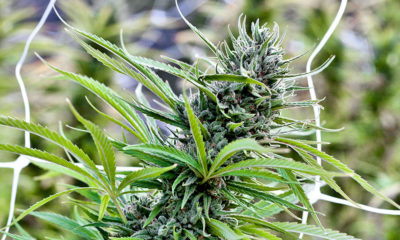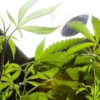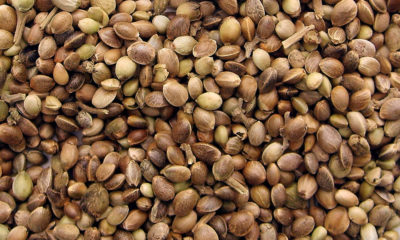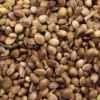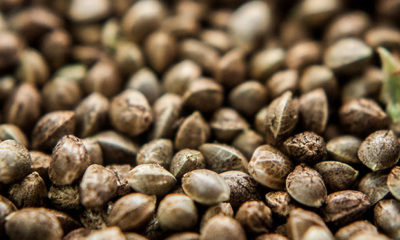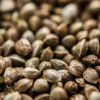
Cannabis
No, You Won’t Be Smoking Hunter S. Thompson’s Weed
Will we really be smoking Dr. Hunter S. Thompson’s stash?
Mainstream media outlets are reporting claims that a Gonzo-branded cannabis line currently in the works will be the result of “cloning” counterculture icon Dr. Hunter S. Thompson’s 12 to 15-year-old head stash. But cannabis bioscience experts say that’s “Jurassic Park stuff.”
In his seminal classic of “gonzo journalism,” Fear and Loathing in Las Vegas, alternative press legend Dr. Hunter S. Thompson wrote that journalism is not a profession but “a cheap catch-all for f**koffs and misfits.”
Perhaps that explains why so many different media outlets have unquestioningly run the same silly, unscientific story about “cloning” the good doctor’s “personal marijuana and hashish” stash from dried up, 12 to 15-year-old remnants, never once asking the big questions like “how can you clone hashish?”
This madness all started with an article in the Aspen Times about the future of Dr. Thompson’s Owl Farm property — his “fortified compound” in Woody Creek, Colorado. In the piece, his widow Anita Thompson spoke about her plans for a “Gonzo” branded line of cannabis products to be sold in Colorado dispensaries.
Anita said she’s passed up several previous offers by cannabis companies looking to incorporate Dr. Thompson’s likeness and Gonzo symbol into their branding, partially because she’s been focused on promoting his literary legacy (which she now considers secure), but also because she had concerns regarding authenticity.
“I’ve had probably 10 meetings in the last three years and I always ended up saying ‘No’ because it’s the same story every time: somebody wants to slap Hunter’s name on their strain,” she said. “If I put Hunter’s name on somebody else’s strain I can never go back and say, ‘No, this is the authentic one.’”
It’s hard to criticize that sentiment, but as anybody who still yearns for just one more rip of authentic Trainwreck or ’90s Northern Lights can tell you, sometimes “goodbye” isn’t the same as “see you later” when it comes to incredible cannabis.
But Anita, who married Hunter in 2003, made a shocking announcement in a public social media post clarifying her statements to the Aspen Times.
“I have found a legal method to extract the DNA from Hunter’s personal marijuana and hashish that I saved for 12-15 years,” she said. “I am in the process of making the strains available to those who would like to enjoy the authentic Gonzo strains in legal states.”
She has not yet responded to Cannabis Now’s attempts to contact her for further details.
But Nishan Karassick, CEO of Phylos Bioscience — a cannabis-focused biotechnology company based out of Portland, Oregon — told Cannabis Now that such a technologically advanced cloning process would require a scientific leap of dinosauric proportions.
“That’s Jurassic Park stuff,” he said. “They’re doing some of that stuff for National Geographic, working with DNA from wooly mammoths and passenger pigeons, but that’s a major undertaking. That’s not like ‘I’ll do this in my spare time,’ you’ve got to dedicate millions and millions of dollars.”
When asked about the theoretical possibility of utilizing tissue culturing — an advanced, somewhat cost-prohibitive cloning process that utilizes tiny plant fragments instead of intact cuttings — Karassick said it would require material much fresher than 12 to 15-years-old.
“We’re talking days, not even months… It can’t be dead, the fresher the better,” he said. “If you took a dry stem, for example, you couldn’t tissue culture from that, it just degrades so rapidly — all the cells are dying.”
But he does believe tissue culture will be a big part of the future of cannabis cultivation. The ability to harness the winning phenotype of a particular strain without importing health and pest issues plaguing the “mother” plant could be a real game-changer for the industry, which is why Phylos has an exploratory program around the technology.
But Karassick, whose company specializes in DNA profiling of cannabis strains, said the basic premise of recapturing a lost phenotype — though not the same as “cloning” a depleted genetic line — is feasible, provided you allow a fair amount of artistic license when it comes to the “recapturing.”
“You can sequence the DNA, and you can see what the nearest relative is,” he said. “Maybe you can identify something similar to a strain Hunter S. Thompson liked to smoke… but in terms of cloning a dried stash, the technology just isn’t there.”
We all want this story to be true at Cannabis Now, but just like we’ll never get the chance to smoke with Dr. Thompson, we’ll never really get to smoke selections from his “serious drug collection.” Whatever herb and hash Anita has held on to for over a decade may have great sentimental value, but most likely isn’t even worth smoking after that many years, let alone using as a source for a new genetic line.
And let’s be honest: cannabis cultivation and breeding technology have come a long way since the doctor took his last toke. He was always living at and just over “the edge,” and if he were still with us, it’s highly likely he’d be smoking (and dabbing) on the strongest, weirdest highs he could find — not the same stuff he was puffing 10 years ago.
So while this story is definitely too good to be true, it isn’t too good to check. And sadly, this isn’t the dawn of Jurassic Park technology for cannabis. It’s just more evidence supporting the good doctor’s theory that “the truth is never told during the nine-to-five hours.”
TELL US, do you plan to buy Gonzo cannabis when it becomes available?



